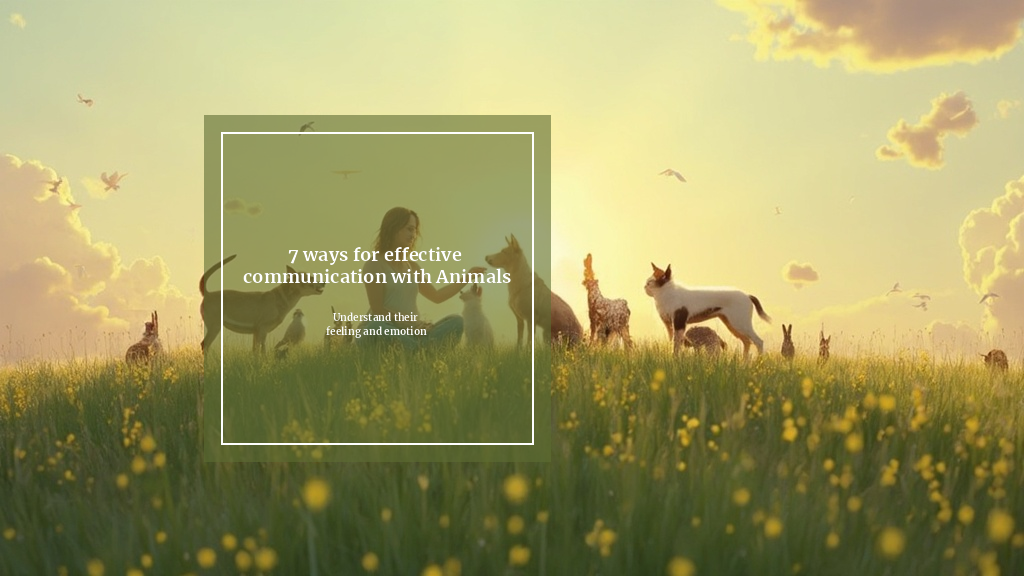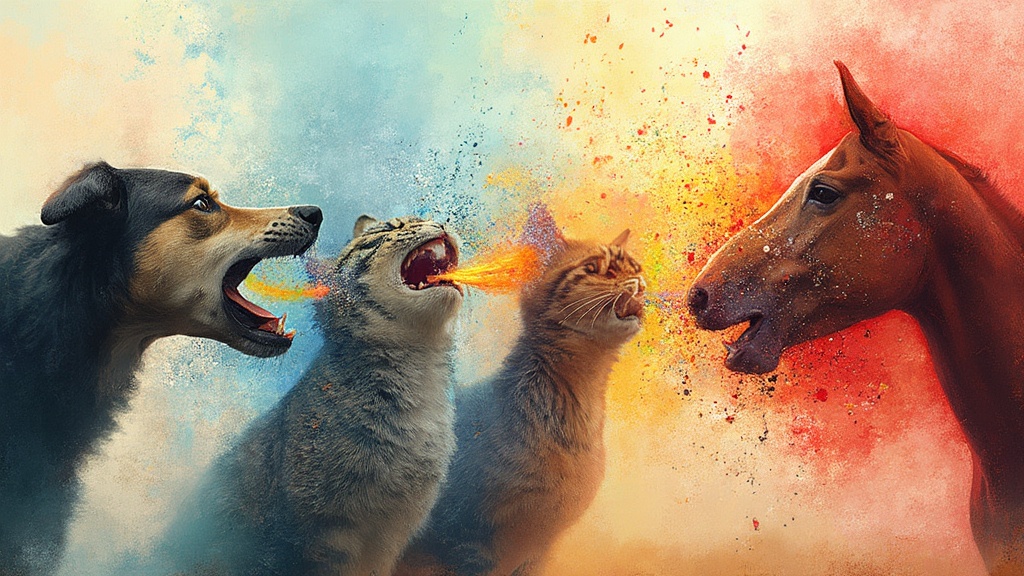7 Ways for Effective Communication with Animals

Table of Contents
Introduction
Communication with animals is an art that goes beyond words. It’s about understanding the subtle cues, body language, and energy that our animal companions use to express themselves. By learning to interpret these signals, we can build stronger bonds with our pets and gain insights into their needs and emotions.
In this blog post, we’ll explore seven effective ways to communicate with animals, drawing from scientific research, expert insights, and practical experiences. Whether you’re a pet owner, animal lover, or aspiring animal communicator, these techniques will help you deepen your connection with the animal kingdom.
For those looking to take their animal communication skills to the next level, the Animal Communication Specialist course offers comprehensive training in interspecies communication techniques.
1. Understanding Animal Body Language

Body language is the primary form of communication for most animals. Learning to read and interpret these physical cues is crucial for effective interspecies communication.
Key Body Language Signals:
- Tail position and movement
- Ear positioning
- Facial expressions
- Posture and stance
- Eye contact and gaze direction
For example, a dog with a wagging tail doesn’t always indicate happiness. The speed, height, and direction of the wag can convey different emotions, from excitement to anxiety. Similarly, a cat’s tail position can signal various moods, from contentment (upright with a slight curve) to agitation (puffed up and bristled).
To improve your understanding of animal body language, spend time observing different species in various situations. The Center for the Integrative Study of Animal Behavior at Indiana University offers valuable resources on animal behavior research, which can enhance your knowledge of body language interpretation.
Case Study: Monty Roberts, known as the “Horse Whisperer,” revolutionized horse training by closely observing and responding to equine body language. His “Join-Up” method, which establishes trust through non-verbal communication, has transformed the lives of countless horses. Roberts’ techniques demonstrate the power of understanding and respecting animal body language. Learn more about his groundbreaking work on his official website.
| Animal | Relaxed Body Language | Stressed Body Language |
|---|---|---|
| Dog | Loose body, wagging tail, soft eyes | Stiff body, tucked tail, whale eye |
| Cat | Slow blinks, kneading, upright tail | Flattened ears, puffed tail, dilated pupils |
| Horse | Lowered head, relaxed ears, soft eyes | Head high, pinned ears, tense muscles |
By honing your skills in reading animal body language, you’ll be better equipped to understand and respond to your pet’s needs, fostering a stronger bond and more effective communication.
2. Interpreting Animal Vocalizations

Animal vocalizations are another crucial aspect of interspecies communication. Each species has its own unique repertoire of sounds, each carrying specific meanings.
Common Vocalizations and Their Meanings:
- Dogs: Barking, growling, whining, howling
- Cats: Meowing, purring, hissing, chirping
- Birds: Singing, chirping, squawking
- Horses: Neighing, whinnying, snorting
It’s important to note that vocalizations should be interpreted in context with body language and the surrounding environment. For instance, a dog’s bark can indicate excitement, alarm, or a request for attention, depending on the situation and accompanying body language.
To improve your understanding of animal vocalizations, consider the following tips:
- Listen attentively to the pitch, volume, and duration of sounds
- Observe the context in which vocalizations occur
- Pay attention to the frequency and urgency of the sounds
- Notice any patterns or combinations of vocalizations
Case Study: The Interspecies Internet project, founded by experts including musician Peter Gabriel and cognitive psychologist Diana Reiss, aims to facilitate communication between humans and other species through technology. Their work includes studying vocalizations of various animals, including dolphins and great apes, to decode their communication patterns. Learn more about their groundbreaking research on the Interspecies Internet website.
By developing your skills in interpreting animal vocalizations, you’ll gain valuable insights into your pet’s emotional state and needs, leading to more effective communication and a stronger bond.
3. Recognizing Scent Communication

Scent communication plays a vital role in the animal kingdom, often conveying information that’s invisible to human perception. Many animals rely heavily on their sense of smell to gather information about their environment, other animals, and potential threats or opportunities.
Key Aspects of Scent Communication:
- Territorial marking
- Identifying individuals
- Detecting emotional states
- Signaling reproductive status
- Locating food sources
While humans can’t detect most animal scents, we can observe behaviors related to scent communication. For example, when a dog stops to sniff during a walk, they’re gathering information about other animals in the area, potential food sources, or changes in their environment.
To better understand and respect scent communication:
- Allow your pet ample time to explore and sniff during walks or outdoor time
- Be mindful of your own scent and how it might affect your pet
- Avoid using strong fragrances that might interfere with your pet’s natural scent communication
- Observe how your pet reacts to different scents in their environment
Understanding the importance of scent communication can help you create a more enriching environment for your pet and respect their natural behaviors. This knowledge is particularly valuable when introducing new animals to each other or helping a pet adjust to a new home.
For those interested in learning more about animal communication, including scent-based interactions, the benefits of alternative medicine article explores holistic approaches to animal care that consider all aspects of communication and well-being.
4. Utilizing Touch Communication

Touch is a powerful form of communication for many animals, including humans. It can convey comfort, affection, reassurance, and even establish social hierarchies. Understanding how to use touch effectively can significantly enhance your bond with animals.
Effective Touch Communication Techniques:
- Gentle petting and stroking
- Grooming and massage
- Respectful handling during care routines
- Using touch to guide or redirect
It’s crucial to remember that touch preferences can vary greatly between individual animals and species. Some animals may find certain types of touch comforting, while others might find them stressful. Always observe an animal’s body language and respect their boundaries when using touch communication.
Time Required: 5-15 minutes daily
Materials Needed: Clean hands, grooming tools (optional)
To improve your touch communication skills:
- Start with gentle, slow movements
- Pay attention to the animal’s response and adjust accordingly
- Learn your pet’s favorite spots for petting or massage
- Use touch in combination with calm, soothing vocalizations
- Practice consistency in your touch communication
Benefits:
- Strengthens the bond between humans and animals
- Reduces stress and anxiety in both pets and their owners
- Can help in early detection of health issues through regular physical contact
- Promotes relaxation and overall well-being
Case Study: The Elephant Nature Park in Thailand, founded by Sangduen “Lek” Chailert, demonstrates the power of touch in rehabilitating rescued elephants. Lek’s gentle approach, which includes physical touch and soothing vocalizations, has helped numerous traumatized elephants recover and form new social bonds. Learn more about Lek’s inspiring work on the Elephant Nature Park website.
By mastering touch communication, you can create a deeper, more trusting relationship with your animal companions. This skill is particularly valuable in animal-assisted therapy settings, where touch can play a crucial role in healing and emotional support. For more information on this topic, explore the article on animal-assisted therapy in communication sciences and disorders.
5. Reading and Responding to Animal Energy

Animals are highly attuned to energy, both from their environment and from other beings. Learning to read and respond to an animal’s energy can provide valuable insights into their emotional state and needs, allowing for more effective communication.
Key Aspects of Energy Reading:
- Observing an animal’s overall demeanor
- Sensing changes in the animal’s energy field
- Recognizing how your own energy affects animals
- Practicing mindfulness and presence
Energy reading is often considered a more intuitive form of communication, but it can be developed with practice and awareness. By tuning into an animal’s energy, you may be able to sense their emotional state, physical discomfort, or even pick up on past traumas that are affecting their current behavior.
Time Required: 10-20 minutes daily for practice
Materials Needed: Quiet space, comfortable seating
To improve your energy reading skills:
- Practice mindfulness and meditation to increase your sensitivity to energy
- Spend time quietly observing animals without agenda or expectation
- Pay attention to your own emotional state and how it might influence your perceptions
- Keep a journal of your observations and any patterns you notice
- Seek guidance from experienced animal communicators or energy workers
Benefits:
- Enhances your ability to understand and respond to an animal’s needs
- Helps in identifying and addressing emotional or behavioral issues
- Deepens the bond between humans and animals
- Can lead to more harmonious multi-pet households
For those interested in developing their energy reading skills, the Animal Talk website offers valuable tips and resources on animal communication, including energy reading techniques.
By honing your ability to read and respond to animal energy, you’ll open up new channels of communication and understanding with your animal companions. This skill can be particularly beneficial when working with rescue animals or in situations where an animal’s history is unknown.
6. Developing Intuitive Communication

Intuitive communication with animals involves tapping into a deeper level of understanding that goes beyond physical cues and vocalizations. It’s about developing a mental and emotional connection that allows for a more profound exchange of information and emotions.
Key Elements of Intuitive Communication:
- Mental imagery and visualization
- Emotional attunement
- Telepathic exchange of thoughts
- Receiving and interpreting intuitive impressions
While intuitive communication may seem mystical, many animal behaviorists and communicators believe it’s an innate ability that can be developed with practice and patience.
Time Required: 15-30 minutes daily for practice
Materials Needed: Quiet space, journal for recording experiences
To develop your intuitive communication skills:
- Practice regular meditation to quiet your mind
- Set clear intentions to connect with an animal
- Start with animals you know well and gradually expand to others
- Be open to receiving information in various forms (images, feelings, words)
- Keep a journal of your experiences and validate them when possible
Benefits:
- Allows for deeper understanding of an animal’s thoughts and feelings
- Can help identify and address underlying issues affecting an animal’s behavior
- Strengthens the emotional bond between humans and animals
- May provide insights that aren’t apparent through other forms of communication
For those interested in exploring intuitive communication further, the creative ways to use art therapy article offers techniques that can enhance your intuitive abilities and emotional awareness, which are valuable skills in animal communication.
Remember, developing intuitive communication takes time and practice. Be patient with yourself and approach the process with an open mind and heart.
7. Observing Environmental Cues

Animals are constantly interacting with their environment, and these interactions can provide valuable insights into their needs, preferences, and state of mind. By carefully observing how animals respond to their surroundings, we can gain a deeper understanding of their communication cues.
Key Environmental Cues to Observe:
- Changes in routine or habitat
- Reactions to specific objects or areas
- Preferences for certain locations or surfaces
- Responses to environmental stimuli (sounds, smells, sights)
- Interaction with enrichment items or toys
Understanding environmental cues can help you create a more comfortable and stimulating environment for your pets, as well as identify potential sources of stress or discomfort.
Time Required: Ongoing observation during daily interactions
Materials Needed: Notebook for recording observations, various enrichment items
To improve your ability to interpret environmental cues:
- Regularly assess your pet’s living space for potential stressors or areas of comfort
- Introduce new objects or rearrange the environment to observe reactions
- Pay attention to how your pet uses different areas of their habitat
- Notice patterns in behavior related to time of day or seasonal changes
- Experiment with different types of enrichment and note preferences
Benefits:
- Helps create a more comfortable and enriching environment for animals
- Allows for early detection of potential health or behavioral issues
- Enhances your understanding of an animal’s individual preferences and needs
- Improves overall quality of life for pets
By becoming more attuned to environmental cues, you can make informed decisions about your pet’s care and living conditions. This awareness can lead to a happier, healthier pet and a stronger human-animal bond.
For more insights on creating a supportive environment for your pets, consider exploring natural supplements for better health, which can complement your efforts to provide a holistic approach to animal care.
Conclusion
Effective communication with animals is a multifaceted skill that involves understanding body language, vocalizations, scent cues, touch, energy reading, intuitive communication, and environmental awareness. By developing these seven key areas, you can significantly enhance your ability to connect with and understand your animal companions.
Remember that each animal is unique, and what works for one may not work for another. Patience, practice, and an open mind are essential as you develop your interspecies communication skills. The journey of learning to communicate more effectively with animals is not only rewarding but can also lead to deeper, more fulfilling relationships with the creatures who share our lives.
As you continue to explore and refine your animal communication skills, consider seeking additional resources and training to further your knowledge. The field of animal communication is constantly evolving, with new insights and techniques emerging regularly.
By investing time and effort into improving your communication with animals, you’re not only enriching your own life but also contributing to the well-being and happiness of the animals in your care. Whether you’re a pet owner, animal professional, or simply an animal lover, the skills you develop will serve you well in all your interactions with the animal kingdom.
Explore More
References
- https://www.elephantnaturepark.org/about-us/our-founder/
- https://www.interspecies.io
- https://montyroberts.com/about-monty-roberts/
- https://animalbehavior.indiana.edu/research/index.html
- https://animaltalk.net/AboutAnimalCommunication/AnimalCommunicationTips/
- https://thehumaneleague.org/
- https://www.speechpathology.com/articles/animal-assisted-therapy-in-communication-20420











Responses